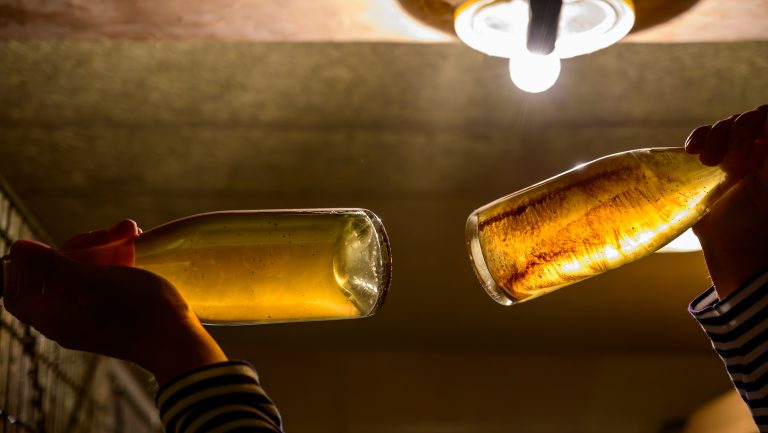After being cooped up tightly inside a bottle, a wine often needs a breath of fresh air to express itself and show its full range of aromatics. Pouring wines into a decanter is a common way to get them to do just that. As the wine splashes and flows inside the decanter, air interacts with it. Some odors dissipate, others come to the forefront, and the wine is often found to become more expressive. At the same time, the mouthfeel may soften, as tannins appear to lose their hard edges. But what’s actually happening on a chemical level?
At the most basic level, the additional air is enough to make the wine present differently, says Jamie Goode, PhD, who has written several books about the sensory and biochemical aspects of wine science. Says Goode, “Air is conducive to carrying the aromatic compounds and, thus, to liberating them.” In other words, there are just more things to smell as the compounds rise into the air.
Beyond that, two primary mechanisms are at work when wine is aerated, says Maurizio Ugliano, a professor of enology at the University of Verona, Italy, who specializes in oxygen management in wine. They are evaporation and oxidation. Evaporation releases alcohol and other compounds from the solution. Oxidation involves the breakdown or recomposition of compounds through their interaction with oxygen.

Don’t miss the latest drinks industry news and insights. Sign up for our award-winning newsletters and get insider intel, resources, and trends delivered to your inbox every week.
Understanding Evaporation
When a wine is decanted, what happens first is evaporation, which rapidly releases alcohol and other chemical elements, notably aromatic ones that are present in the wine. “Evaporation takes place instantly,” Ugliano says, “so it might be more impactful on a sensory level.”
Low-boiling sulfur compounds associated with reductive characteristics tend to evaporate quickest. These compounds include hydrogen sulfide, which manifests in swampy or rotten-egg aromas; free sulfur dioxide, which smells like matchstick and smoke; and some types of mercaptans, which result in notes of canned vegetables, onion, and garlic. The first two, in particular, are the elements that “blow off,” or quickly disappear. However, the volatility of mercaptans, a large family of compounds, is more variable, with some notes evaporating easily and others that persist even with prolonged oxygen exposure.
Michael Madrigale, a wine consultant and former head sommelier at Bar Boulud in New York City, notes that much of the rationale for decanting is about removing unwanted things. “You’re battling with elements of a wine that need to blow off,” he says, “like sulfury and reductive elements, and that’s true with old wines as well, which often have a bit of a stink when you open them.” In the case of older bottles, decanting also removes solids and fine sediment that could yield a coarser texture in the glass or give the wine unwanted astringency.
With sulfur-based compounds dropping off, more room is left for aromatic compounds to be perceived, like fruity aromas. “When you swirl a glass,” says Madrigale, “you force fruity esters and other aromatic elements to get carried by the oxygen, and they become easier to perceive. Decanting does the same thing on a larger scale. It agitates and releases the aromas so you can smell them better.”
A 2016 study in the Journal of Agricultural and Food Chemistry supports the assertion that evaporation is the main force at work when wines are decanted. In the study, wine lost 1 percent alcohol by volume over a period of two hours, and up to 3.2 percent over six hours, when left in an open glass subject to continuous airflow. Upon chemical analysis, the aeration caused certain volatile compounds to drop considerably over the same time periods. Further, wines that had been aerated were also easy to distinguish from those that had not been aerated, as supported by sensory analysis.
The study showed that evaporation rates increased when wines were put into wider glasses. Larger vessels, such as decanters, provide an even greater surface area for air contact, increasing the release of alcohol and other compounds. As a wine’s alcohol levels drop, its texture may change as well, since higher alcohol levels correlate with perceptions of added roundness. The impression of alcoholic heat on a wine’s finish may also lessen with aeration.
While air exposure has benefits, particular care should be taken when decanting older wines. Aromatic compounds become oxidized over time in the bottle and are more fragile and subject to loss than in younger wines. For older vintages, “decant and serve immediately,” Madrigale says, “so the wine doesn’t lose its mojo.”
The Limits of Oxidation
The term oxidation refers to chemical reactions involving oxygen. While evaporation just moves things around, oxidation involves the transformation of the compounds present in wine—a longer and more complex process. “There’s saturation, at a certain point, because the wine can only take so much oxygen,” Goode says. “So that limits the impact.” For oxidation to take place, oxygen has to enter the solution directly so it can interact with other chemical elements.
In most situations—say, dinner at a restaurant—decanting takes place in a matter of minutes, so oxidative changes are limited, according to Ugliano. “Oxygen reacts with wine quite slowly—over hours or days—so it’s not obvious that aroma-impacting chemical reactions will take place,” he says. “Of course, if you decant and then wait for a couple of hours, some changes due to oxidation will probably take place. However, most people don’t do that.”
Individual wines react to oxygen differently, so the oxidative changes that occur can manifest in various ways. Some grape varieties have aromas that derive from thiols—the blackcurrant note in Cabernet Sauvignon, for example, or the passion fruit in Sauvignon Blanc—and some of those thiols can be broken down relatively quickly by oxygen, correlating with the loss of some fruity aromas. Other varieties contain high levels of antioxidant substances, such as glutathione or phenolic compounds like tannins and anthocyanins, which will intercept oxygen and prevent it from changing the aromas, in some cases even over several days.
The oxygen regimen that took place in the cellar during aging (the use of barrels versus tanks, the frequency of racking or topping up, short versus long cellar aging) can also affect a wine’s sensitivity to oxidation. Wines that have gone through long barrel aging see more oxygen before bottling, which often renders them more stable after the bottle is open. Yet, since most oxidative reactions take several hours or days to show up at detectable levels, evaporation remains the prime source of change in decanted wines.
Beyond Chemistry
Goode, whose books include I Taste Red: The Science of Tasting Wine, points out that the effects of decanting include elements that fall outside of chemical compounds and olfactory interactions. “There’s another very important aspect of decanting,” he says, “and that’s the psychological one. By treating a wine with respect, you’re creating expectations, and I think those expectations are often rewarded.”
In other words, while the chemistry counts, one shouldn’t forget the context surrounding the act of decanting and tasting, including the sense of ritual, the cuisine, and one’s company at a dinner or tasting occasion. “The wine does change over time,” Goode says, “but also we change as we consume the wine. We’re not measuring devices. It’s more like a relationship.”

Dispatch
Sign up for our award-winning newsletter
Don’t miss the latest drinks industry news and insights—delivered to your inbox every week.
Rémy Charest is a journalist, writer, and translator based in Quebec City, Canada. He has been writing about wine and food since 1997 for various Canadian and American print and online publications, including Chacun son vin/WineAlign, Wine Enthusiast, Le Devoir, Le Soleil, EnRoute, Palate Press, Punch Drink, and Châtelaine, and has been a regular radio columnist for CBC/Radio-Canada. He has also judged national and international wine competitions, notably the WineAlign National Wine Awards of Canada, the TEXSOM International Wine Awards, and the International Rosé Championships.







